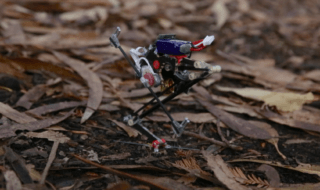Dec 7 2016
A team of roboticists at UC Berkeley have built a small robot that is capable of leaping into the air and then springing off a wall, or performing a number of vertical jumps in a row, resulting in the maximum robotic vertical jumping agility ever to be recorded. The robot’s agility opens new pathways of locomotion that were not achievable in the past. The roboticists hope that this robot and other vertically agile robots would one day be used to leap around rubble in search and rescue missions.
 Salto, for saltatorial locomotion on terrain obstacles (Photo by Stephen McNally).
Salto, for saltatorial locomotion on terrain obstacles (Photo by Stephen McNally).
The robot has been christened Salto (for saltatorial locomotion on terrain obstacles). The researchers observed the galago, a highly vertically agile creature, in order to build the robot. The galago can jump five times within four seconds to gain a combined height of 8.5 m (27.9 ft). The galago is capable of storing energy in its tendons so that it can jump to heights not attainable by just its muscles alone.
To compare the vertical agility of animals and robots, the team created a new metric to calculate vertical agility, defined as the height that something can attain with one jump in Earth gravity, multiplied by the frequency at which that jump can be performed.
Salto’s robotic vertical jumping agility is 1.75 m per second, which is greater than the vertical jumping agility of a bullfrog (1.71 m per second) but lesser than the vertical jumping agility of the galago (2.24). The robot with the second highest vertical agility that the team measured is called Minitaur (1.1 m/s).
Developing a metric to easily measure vertical agility was key to Salto’s design because it allowed us to rank animals by their jumping agility and then identify a species for inspiration.
Duncan Haldane, a robotics Ph.D. candidate at UC Berkeley, lead researcher
Haldane is a student in the Biomimetic Millisystems Lab of Ronald Fearing, a professor of electrical engineering and computer sciences.
The research was published on December 6 in the debut edition of the Science Robotics journal. The research was supported by the U.S. Army Research Laboratory under the Micro Autonomous Systems and Technology Collaborative Technology Alliance, and by the National Science Foundation.
The design of Salto is centered on the power modulation used by the galago. Power modulation is an adaptation found in natural systems (and engineered into some robotic systems) that raises the peak power available for jumping by storing muscular energy in flexible tendons.
The galago can jump so well due to the fact that its tendons are loaded with energy by its muscles when it is in a crouched position. When this process was adapted to Salto, the robot achieved its high vertical agility, which included the wall jump. Within Salto, a motor drives a spring, which loads via a leg mechanism to generate the kind of crouch observed in the galago. Since power modulation is used, Salto does not need to wind up prior to a jump; as soon as it jumps, Salto can repeat that action again.
Salto realized 78% of the vertical jumping agility of a galago. Due to motor power limitations, the finest untethered robot before Salto achieved a vertical jumping agility of just 55% of a galago.
By combining biologically inspired design principles with improved engineering technology, matching the agile performance of animals may not be that far off.
Ronald Fearing, a professor of electrical engineering and computer sciences
Salto is 26 cm (10.2”) tall when fully extended, and weighs 100 g (3.5 oz). It can jump up to one meter. Salto’s highest jump height was approximately 1.008 m (3.3 ft). For the wall jump, Salto realized an average height gain of about 1.21 m (3.97 ft). There are other robots that can jump higher than Salto in a single leap. For instance, TAUB, a locust-inspired jumping robot, can leap to 10.5 ft (3.2 m) in just one jump.
SALTO - Berkeley's leaping robot